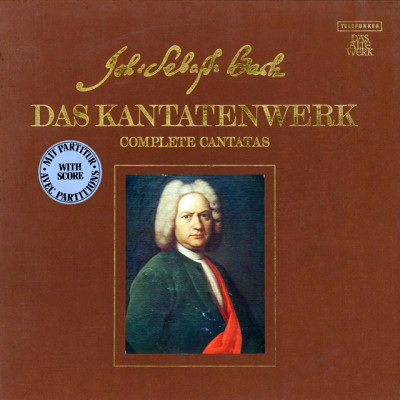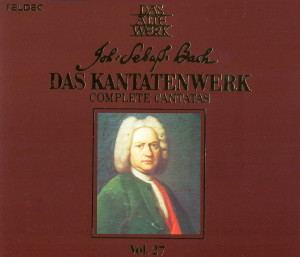 |
|
2 LPs
- 6.35559 EX - (p) 1980
|
 |
| 2 CDs -
242-603-2 ZL - (c) 1989 |
|
| DAS KANTATENWERK - Volume 27 |
|
|
|
|
|
|
|
| Johann Sebastian
BACH (1685-1750) |
Kantate
"Was willst du dich betrüben", BWV
107
|
|
18' 40" |
|
|
Kantate
am 7. Sonntag nach Trinitatis (Dominica
7 post Trinitatis)
|
|
|
|
|
Text:
Johann Heermann 1630
|
|
|
|
|
Solo:
Sopran, Tenor, Baß - Chor; Corno
(Zugtrompete); Flauto traverso I, II, Oboe
d'amore I, II; Streicher; B.c.
(Violoncello, Violone, Organo)
|
|
|
|
|
- 1.
Chor: "Was willst du dich betrüben"
|
3' 32" |
|
A1 |
|
- 2.
Recitativo (Basso): "Denn Gott verlässet
keinen" |
0' 50" |
|
A2 |
|
- 3.
Aria (Basso): "Auf ihn magst du es wagen" |
3' 00" |
|
A3 |
|
- 4.
Aria (Tenore): "Wenn auch gleich aus der
Höllen" |
2' 56" |
|
A4 |
|
- 5.
Aria (Soprano): "Er richt's zu seinen
Ehren" |
3' 04" |
|
A5 |
|
- 6.
Aria (Tenore): "Drum ich mich ihm ergebe"
|
2' 52" |
|
A6 |
|
- 7.
Chor: "Herr, gib, daß ich deine Ehre" |
2' 14" |
|
A7 |
|
|
|
|
|
Marcus
Klein (Solist des Knabenchores
Hannover), Sopran
Kurt Equiluz, Tenor
Max van Egmond, Baß
Knabenchor Hannover |
Heinz Hennig, Leitung
Collegium Vocale Gent | Philippe
Herreweghe, Leitung
Das verstärkte LEONHARDT-CONSORT mit
Originalinstrumenten
- Don Smithers, Zugtrompete
- Frans Brüggen, Walter van Hauwe, Querflöten
- Ku Ebbinge, Bruce Haynes, Oboen
d'amore
- Marie Leonhardt, Lucy van Dael, Alda
Stuurop, Ruth Hesseling (BWV 107,3), Janneke
van der Meer, Antoinette van den Hombergh, Violinen
- Staas Swiestra, Ruth Hesseling, Wiel
Peeters (BWV 107,3), Violen
- Anner Bylsma, Richte van der Meer, Violoncelli
- Anthony Woodrow, Violone
- Gustav Leonhardt, Bob van Asperen (BWV
107,1,3,7), Orgel
Gustav Leonhardt, Gesamtleitung
|
|
|
|
|
Luogo
e data di registrazione |
|
Doopsgezinde Kerk,
Haarlem (Holland) - Novembre 1978
/ Gennaio 1980
|
|
|
Registrazione: live
/ studio |
|
studio |
|
|
Producer |
|
Wolf Erichson
|
|
|
Prima Edizione LP |
|
Telefunken "Das Alte
Werk" | 6.35559 EX | 2 LPs -
durata 34' 51" - 50' 28" | (p)
1980 | ANA
|
|
|
Edizione CD |
|
Teldec Classics |
LC 6706 | 242 603-2 ZL | 2 CDs -
durata 34' 51" - 50' 28" | (c)
1989 | ADD |
|
|
Cover
|
|
Johann Sebastian
Nach, einige Jahre vor seiner
Ernennung zum Kantor in Leipzig.
Gemälde con JJ. Ihle (1720) Bach
Museum Eisenach.
|
|
|
Note |
|
In questo volume sono
presenti anche La Cantate BWV 108,
BWV 109 e BWV 110 a cura del
Concentus Musicus Wien diretto da
Nikolaus Harnoncourt.
|
|
|
|
|
INTRODUCTION
by Ludwig Finscher
»Was willst du dich
betrüben« (BWV 107),
written for the Seventh
Sunday after Trinity, is
probably from the second
annual cycle that Bach wrote
at Leipzig; certainly it was
performed on 23rd July 1724.
It is a chorale cantata, as
are the majority of the
works in that cycle. A most
unusual feature, however, is
the fact that although the
hymn text is used unchanged
throughout, the music of
stanzas 2 to 6, which are
set as »modern« recitatives
and arias, bear virtually no
resemblance to the chorale
tune, which is that of »Von
Gott will ich nicht lassen«
of 1690. This work is,
therefore, a foreign body in
the cycle of 1724/25,
anticipating the later
chorale cantatas BWV 137,
129, 117, 192, 122, 177, 97
and 100. It may well be that
Bach was obliged to use the
chorale text in its original
form in July 1724, because
the usual arranger was not
available, or perhaps
because he had written it
when visiting Cöthen. This
expedient later developed
into the genus »chorale
cantata«.
No less unusual are the
musical details of the work.
The first stanza is set as a
spacious chorale with the
decorated melody in the
soprano line; the
instrumental ritornello and
the chorale are not,
however, thematically or
stylistically linked but
simply follow one another,
the ritornello performing
the function of expressing
the sentiments of sadness
and consolation to which the
words refer. The second
stanza takes the form of a
recitative which eventually
develops into an arioso; the
salient words of the text -
»joy« and »salvation through
God« - are highlighted with
a degree of emphasis that
would hardly be possible in
a true aria. Stanzas 3 to 6
are arias arranged in the
medieval binary »Bar« form
a-a-b, as is the whole
chorale: 2 »Stollen« of two
lines each and an »Abgesang«
of 4 lines. Stanzas 3 and 6
are in the major, the
orchestration is somewhat
fuller, the style almost
dance-like in its buoyancy,
the inflection positively
modern, almost in the galant
manner; the chorale does not
appear at all. The middle
stanzas are in the minor;
they are more lightly scored
and contrast with one
another in accordance with
their texts. Stanza No. 4
depicts Satan rising up and
raging in a quasi-ostinato
continuo motif and wild
coloratura. Stanza No. 5
presents »seine Ehren« (his
honour) and »deine
Seligkeit« (your bliss) as a
pleasant pastoral scene;
this is the only time,
except in the first and last
stanzas, that the hymn tune
is used to emphasise the
main message of the text.
»Er richts zu seinen Ehren«
(He ordains it in his
honour) is the first line
with embellishments, and
»was Gott will, das
geschieht« (what God wills
shall be done) repeats, in
augmentation, the last line.
In the final stanza the
customary four-part chorale
is built into an extended
instrumental siciliano,
recalling the end of the 5th
stanza, which at the
beginning paraphrases the
hymn tune; a highly
effective fourbar epilogue
ending in the major appeafs
to comment once again on the
emotional progression from
sadness to sure faith.
|
  |
|
|